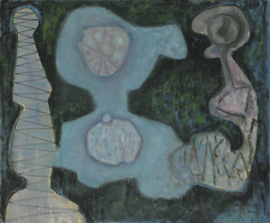
Today’s post comes from Matthew McCardwell, class of 2017 and Art Center Summer Archival Intern
“Concept is now.” This was the opening sentence and kinetic mantra of the spring 1969 exhibition, Concept, at the Vassar Art Gallery—the predecessor to the Frances Lehman Loeb Art Center. This show of conceptual art was the work of Mary Delahoyd’s art history class of thirteen students. Following a previous student-curated exhibition titled Realism Now, this exhibition strove to dissect artwork of the 1960s, focusing on the evolving definition and purpose of art through “non-illusionistic, intellectually and visually rigorous abstraction,” as student Ellie Lawrence noted in her May 2, 1969, article in Vassar’s Miscellany News.
![[left] Frank Stella (American, 1936-) Hagmatana II, 1967 [right] Doug Ohlson (American, 1936-2010), Untitled](http://pages.vassar.edu/fllaceducation/files/2014/11/concept2-300x298.png)
[right] Doug Ohlson (American, 1936-2010), Untitled
The artists represented in Concept included Darby Bannard, Natvar Bhavsar, Howard Buchwald, Elizabeth Damon, Peter Gourfain, Allan Hacklin, Ralph Humphrey, Robert Huot, Patricia Johanson, Robert Mangold, Brice Marden, Kenneth Noland, David Novros, Doug Ohlson, Jules Olitski, Frank Stella, Neil Williams, Larry Zox. The show was on view from April 30 to June 11, 1969.
Accompanying the exhibition was an eighty-nine page catalog. This included artist biographies, a letter from the students, Professor Delahoyd’s scholarly opinion on the exhibition, and photographs of all the works. The artwork in the exhibition was recent, dating back to 1966, serving as a relevant and momentous totem of the of the time period’s evolution in the subject and theory of art. The students decided on the theme, assisted in selecting the works, and wrote the artist biographies. Walls overflowed with color and vast abstraction.
Frank Stella’s Hagmatana II is described as filling an entire wall with color; his Slieve Bawn references a similar scale in FLLAC’s twentieth-century galleries today.
![left] Larry Zox (American, 1937–2006) Plum Gut, ca. 1968, [right] Elizabeth Damon, Untitled](http://pages.vassar.edu/fllaceducation/files/2014/11/concept3-300x297.png)
[right] Elizabeth Damon, Untitled
This tradition of student curation has been carried on at Vassar through a Museum Studies course presently taught by professor of art Susan Kuretsky; through Curator Assistant positions at the Art Center; and through faculty projects in which students participate in the curation of exhibitions as part of their coursework.
Professor Delahoyd said, “If Concept has raised questions, offered new experiences, suggested new ways of seeing and understanding, shaken old values, it has justified its own existence. The reason for the exhibition, as for the very existence of the art which comprises it, can only be as good as its generative idea.”
The curiosity that generated Concept continues to be a force behind exhibitions at the Frances Lehman Loeb Art Center today. Exhibitions by FLLAC curators Mary Kay Lombino and Patricia Phagan, or by guest curators from Vassar’s faculty or from other institutions, challenge us to rethink our perspectives on art and society.
The project of organizing and researching the early exhibition history of the Vassar Art Gallery is ongoing, but it has already served to provoke my curiosity. My hope is that by reading about this one exhibition from 1969, my peers will be inspired to question the process of curation and perhaps generate a new concept—one for our own age.




